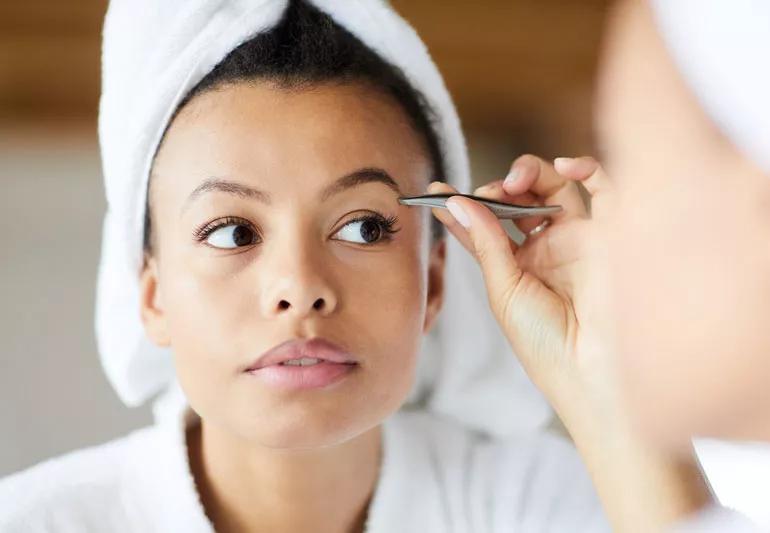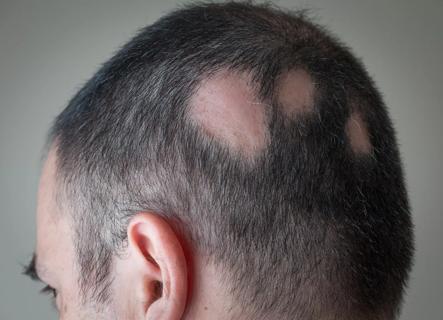How to go from “pencil-thin” to “full and in” (style)

So you’ve recently been a bit overzealous with your eyebrow plucking — with less than stellar results. Or maybe you’re a child of the ‘90s whose look is — shall we say — unintentionally retro. Our message to you: Don’t panic. There’s hope for overplucked eyebrows.
Advertisement
Cleveland Clinic is a non-profit academic medical center. Advertising on our site helps support our mission. We do not endorse non-Cleveland Clinic products or services. Policy
“While it depends on many factors, including the tweezers you use, how often you pluck and how traumatic it is for your hair, you won’t be stuck with thin eyebrows forever,” says dermatologist Shilpi Khetarpal, MD. “Most of the time, they grow back.”
Since the skin around the eyebrows is thin and delicate, says Dr. Khetarpal, it’s easily traumatized. “I tell my patients to get rid of their magnifying mirror because using one means you’re constantly looking at it, plucking and traumatizing those hairs.”
Other factors that affect eyebrow growth include:
Advertisement
To make your face more eyebrow “friendly,” Dr. Khetarpal recommends making these five changes to your eyebrow regimen:
Treat your eyebrows like a relationship that needs repair: Give them the space and time they need. “But if you’re looking in the magnifying mirror every day, obsessing after each hair, your eyebrows will never get the chance to recover,” warns Dr. Khetarpal.
Just say no to tweezers that have a wider, flat end — that’s like using a lawnmower to remove one blade of grass. Instead, choose tweezers with an angled end so you can pull in the direction of your hair growth.
“You can be more precise,” notes Dr. Khetarpal. “Also, avoid tweezers with rubber grips on the end. The rubber creates more friction, which causes more trauma to the hair when you pull it out.”
Skin tends to be softer and more delicate right after a shower. The result? Brow hairs slide right out with minimal effort.
Eating a well-balanced diet can supercharge eyebrow growth. And if you aren’t getting needed nutrients from food, try taking a supplement or two. Of course, talk to your doctor before starting a new supplement regimen.
“A multivitamin can be helpful,” explains Dr. Khetarpal. “Getting enough iron is important, too. So if you eat red meat fewer than two or three times a week, an iron supplement may be a good idea. And if you don’t regularly eat fish and shellfish, omega-3 supplements have also been shown to be helpful.”
Dr. Khetarpal also recommends taking between three to five milligrams of biotin every day. “That’s a large dose, but since biotin is water-soluble, your body takes what it needs and gets rid of the rest through urine.”
Bimatoprost (brand name Latisse®) is a prescription topical used to lengthen and thicken eyelashes. “It’s been shown to help brows, too,” says Dr. Khetarpal.
If you prefer the over-the-counter route, try 2% or 5% minoxidil (brand name Rogaine®). While it’s meant for hair growth on the scalp, it can also stimulate hair growth on thin eyebrows.
But Dr. Khetarpal says there are two cautions for Rogaine use:
When it comes to eyebrow regrowth, patience is key. “Give it at least two to three months to see hair growth. The hair growth cycle for eyebrows is between three and four months, so you need enough time for the hair to respond to your changes,” recommends Dr. Khetarpal.
If you still don’t see the results you want after four months, see a dermatologist. They have many non-DIY options you can try, including:
Advertisement
Advertisement
Learn more about our editorial process.
Advertisement

Take steps to reduce stress by practicing meditation, finding time to relax and maintaining a healthy lifestyle

You may see pitting, brittleness or ridges in your fingernails and toenails

Your immune system may attack hair follicles anywhere on your body

It’s normal to lose around 50 to 150 strands per day to routine hair shedding

Studies are mixed, but frequently wearing very tight, warm hats could stress your follicles and lead to hair loss

Things like stress, heated styling and other health conditions may cause you to lose more hair than normal

Creatine does cause some side effects, but hair loss probably isn’t one of them

A gentle hair care routine, stress reduction and sun protection can help reduce flares and maintain your locks

Babies can get congested easily, but you can calm their cough by keeping them hydrated, using nasal drops and running a humidifier

Weight loss may cause loose, sagging skin and muscle loss to your rear

Several conditions, like vitiligo and fungal infection, can cause a loss of pigmentation, leading to white spots or patches on your skin